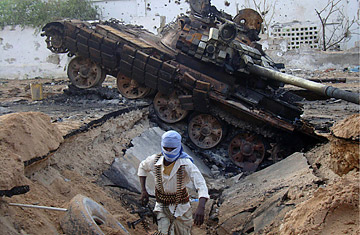
An al-Shabab fighter runs for cover near a burned African Union military tank in Mogadishu on July 2, 2010
The concerns and agenda of Somalia's al-Shabab militia are very much rooted in local politics. However, its rise to prominence is tied to decisions taken by the U.S. and its regional allies in pursuit of the Bush Administration's global war on terrorism.
Following the 9/11 attacks, the U.S. deemed the 10-year power vacuum in Somalia a potential refuge for al-Qaeda, one that prompted Washington, together with African allies, to arm and fund various Somali warlords. In 2004, some warlords were drawn together into the Transitional Federal Government (TFG). However, successive attempts to establish a government were based on clan alliance and were inherently unstable because of the zero-sum character of the clans' competition for resources.
The TFG failed to transcend the predatory warlord politics that had prevailed for 15 years, and in 2006, the Islamic Courts Union (ICU), an Islamist alliance that eschewed the politics of clans, seized control of Mogadishu, rapidly bringing order and economic improvement to their expanding areas of control, thanks to the enthusiastic support of the Somali business community. Thousands of men and women welcomed them, clapping and singing in joy as the ICU's victory convoy coursed through formerly warring neighborhoods.
But the movement's Islamist colors, and the fact that the ICU was said to have given shelter to a handful of wanted al-Qaeda suspects, did not sit well with the U.S. State Department's sole Somalia analyst in the region at the time. And for Washington, the ICU became an intolerable alternative.
With apparent U.S. approval, Ethiopia used funds provided by Washington to buy weapons from North Korea, smuggling them in through Somaliland — a breakaway region of Somalia desperate for international recognition. The U.S. then backed an Ethiopian invasion to restore the TFG to power. During the ensuing fighting, up to 16,000 Somalis were killed and 1 million were displaced. The Islamist leadership was driven out of Mogadishu. The ICU's armed wing, known as al-Shabab (the Youth), initiated an insurgency against the Ethiopian occupation and its Somali accomplices and used tactics seen in Iraq, such as improvised explosive devices and suicide bombings. The Shabab had been a radical faction of the ICU, but was far from dominant. The Ethiopian invasion not only ended the ICU experiment in governance but also legitimized the more militant outlook of the Shabab.
The resulting instability in Somalia has been infused not just with the U.S. global agenda against al-Qaeda, but also with the agendas of regional adversaries — the proxies of Ethiopia against Eritrea and even those of Egypt, Yemen and other Arab states against Ethiopia. Those agendas further complicate Somalia's political-military landscape, propelling the country into cyclical foreign interventions. If the African Union forces pulled out, the TFG would almost certainly disappear. But if the Shabab then managed to plant its flag and declare that it was in control, the U.S. would once again find the situation intolerable. Disengagement is unlikely. And every time there has been an increase of foreign involvement, the Shabab — or its equivalent — only grows and becomes more radicalized.
Is there an exit strategy? One reason the ICU was able to take power was that it provided the best environment for business, and offered a better deal for Somalis than the warlords did. Ultimately, it may be the business communities of the various clans that will be the kingmakers, and perhaps the key to stability.
Rosen is a fellow at the New York University Center on Law and Security and author of the forthcoming book Aftermath: Following the Bloodshed of America's Wars in the Muslim World
